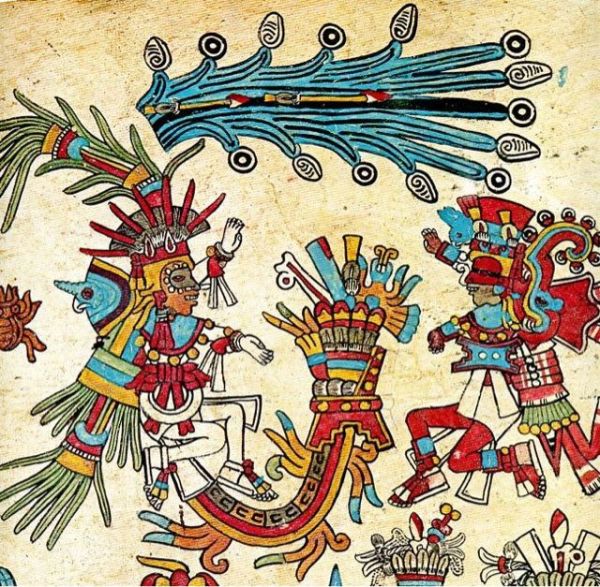Acuecucyoticihuati
Macuilxochitl
Macuilxochitl was one of several Aztec Gods devoted to pleasure. He was patron of games in general, for example the ancient board game of patolli ( modern pachisi), and of all the celebrations associated with them, but was especially associated with the sacred ball game tlachtli. Macuilxochitl was identified with the calendrical day-name “5 flower” through his relation to Xochipilli, but was also called Ahuíatl and Ahuiatéotl, one of the five genies of the south. In general, the brothers Macuilxochitl, Ixtlilton and Xochipilli together comprise three aspects of good health, pleasure and well-being. Macuilxochitl being the aspect given over more to excess or over-indulgence in pleasure. In this last capacity he was particularly associated with the name Ahuiatéotl.
Cuaxólotl
Cuaxólotl was the Aztec goddess of the hearth and an alternative name for CHANTICO. She was portrayed with two heads, to symbolize both the good and evil potentials of fire.
Civatateo
Civatateos are Vampire or Witches like who used to attend Sabbaths at crossroads and were believed to attack young children and to mate with human men, giving birth to children born as vampires.
Civatateo originated in Mexico, where they are bound to the Aztec God Tezcatlipoca.
In Aztec mythology, the Civatateo are noblewomen who died during childbirth and, after returning to the land of the living, stalk travelers and haunted temples.
Civatateos are servants of the Aztec moon deities Tezcatlipoca and Tlazolteotl.
They can be prevented from attacking the living by placing food on shrines built at the crossroads.
Their favourite offering is a cake in the shape of a butterfly. But that wasn’t their only reason, they also hoped that a Civatateo would be so busy eating its feast it wouldn’t notice the rising sun, for the sun would kill a Civatateo.
Civatateo are said to look:
•shriveled and pale
•with faces are white, and their hands and arms are covered in ticit, (a type of white chalk)
•with their tattered dresses decorated with crossbones.
Tzitzimime
In Aztec mythology, a tzitzimitl (plural tzitzimimeh) is a deity associated with stars. They were depicted as skeletal female figures wearing skirts often with skull and crossbone designs. In Postconquest descriptions they are often described as “demons” or “devils” – but this does not necessarily reflect their function in the prehispanic belief system of the Aztecs.
The Tzitzimimeh were female deities, and as such related to fertility, they were associated with the Cihuateteo and other female deities such as Tlaltecuhtli, Coatlicue, Citlalinicue and Cihuacoatl and they were worshipped by midwives and parturient women. The leader of the tzitzimime was the Goddess Itzpapalotl who was the ruler of Tamoanchan – the paradise where the Tzitzimimeh resided.
The Tzitzimimeh were also associated with the stars and especially the stars that can be seen around the sun during a solar eclipse. This was interpreted as the Tzitzimimeh attacking the sun, this caused the belief that during a solar eclipse, the tzitzimime would descend to the earth and devour human beings. The Tzitzimimeh were also feared during other ominous periods of the Aztec world, such as during the five unlucky days called Nemontemi which marked an unstable period of the aztec year count, and during the New Fire ceremony marking the beginning of a new calendar round – both were periods associated with the fear of change.
The Tzitzimimeh had a double role in Aztec religion: they were protectresses of the feminine and progenitresses of mankind. But they were also powerful and dangerous, especially in periods of cosmic instability. They are harbingers of evil and destruction. As you might expect.
Piltzintecuhtli
Piltzintecuhtli is the Youthful Lord, a solar deity. According to some, he is the planet Mercury. Mercury is the sun’s little brother, the planet that is visible just before sunrise or just after sunset.
Piltzintecuhtli is the son of Oxomoco and Cipactonal, the first man and the first woman. His wife is Tlazolteotl. He is the father of Centeotl.
Piltzintecuhtli is third Lord of the Night.
Cihuateteo
Cihuateteo or Cihuapipiltin, the divine or noble women, the goddesses of the crossroads. They can be dangerous goddesses, spirits of women who died in childbirth, and now live on, escorting the setting sun. At noon they take over the escort from the warriors who have died in combat.
The Cihuateteo are closely related to the Tzitzimime (like for example the goddess Itzpapalotl), the star daemons that are protectors of midwives and women in labor.
The Cihuapipiltin have special influence on days 1-Calli (House), 1-Mazatl (Deer), 1-Ozomahtli (Monkey), 1-Cuauhtli (Eagle), 1-Quiahuitl (Rain).
On these days, after sunset, the Cihuapipiltin go to the crossroads to steal children and seduce men to commit aldultery.
Itztli
Mictlancihuatl
Citlalicue
Citlalicue (also Citlalinicue), Her Skirt is Stars, is also known as Ilamatecuhtli. She is a creator goddess, goddess of the stars and the Milky Way, earth, death and darkness.
With het husband Citlalatonac she created the stars. Citlalicue and Citlalatonac are sometimes associated with the first pair of humans, Nata and Nena.
As Ilamatecuhtli she is associated with Cihuacoatl.
In the tonalpohualli, Citlalicue is the Lord of the Day for days with number 13 (mahtlactli-omei in Nahuatl).








